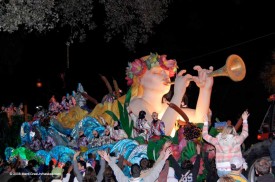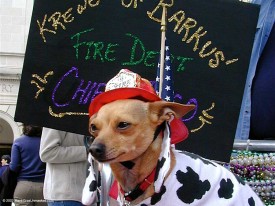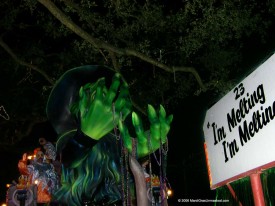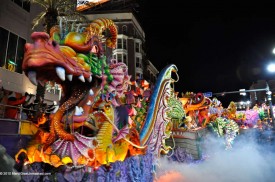New Orleans Mardi Gras parades are a feast for the senses, with floats that bemuse and entertain, bands full of joyful noise, inspired dance troupes and showers of baubles that stoke an exhilarating feeding frenzy. Can’t you almost feel da boom of dat big bass drum?
Mardi Gras parade customs, etiquette,
safety and preparedness
Captain Eddy’s SS Endymion
Endymion is Carnival’s biggest parade, and the only one that rolls on the Mid-City route.
The “official” Mardi Gras parade season always starts 11 days before Fat Tuesday, on a Friday. These are thematic parades featuring floats, marching bands, drill teams, flambeaux and other units. They’re named after private Carnival organizations, or krewes, whose dues-paying members ride on the floats or participate in other ways, such as riding on horses. Float parades are sanctioned by the New Orleans City Council. That is what makes them, in a sense, “official.”
When people refer to “parades” in the context of Mardi Gras, they generally mean “mainstream” float parades that follow an officially designated route. In New Orleans, there are three basic parade routes — Uptown, West Bank and Mid-City. Of the 30 parades that comprise the official 2012 schedule, 24 will roll Uptown and five on the West Bank (located across the Mississippi River from downtown New Orleans). The Krewe of Endymion is the only parade that rolls on the Mid-City route.
The French Quarter hosts a variety of smaller-scale processions that are not part of the official parade schedule (which is to say, they may be issued permits by the city but typically aren’t sanctioned in the municipal code like mainstream parades). Two are particularly noteworthy for drawing big crowds: the Mystic Krewe of Barkus, an eye-popping multitude of costumed canines, and the ribald Krewe du Vieux. Known for bawdy satire (parental discretion advised), the Krewe du Vieux, which always rolls on the third Saturday before Fat Tuesday, is widely regarded as the kick-off to the New Orleans parade season. Barkus always takes to the streets on the second Sunday before Fat Tuesday.
What’s often referred to as the “first weekend of Mardi Gras” includes Barkus as well as the float parades that begin on Friday night and continue through Sunday afternoon. Locals tend to regard this weekend as a warm-up. For prospective visitors wary of big crowds, or wanting to experience a more local flavor, the first weekend is a good option. Parades start up again the following Wednesday, with momentum and energy continuously building through the second weekend and on up to the climax of the festivities, Fat Tuesday.
Chief Taco, a paw-ticipant in the 2002 Mystic Krewe of Barkus parade
The French Quarter procession is always a big crowd-pleaser on the first weekend of Mardi Gras.
By the Saturday of the second weekend, the city is positively abuzz with activity, and you’ll find yourself having to compete for space to watch parades. As you might expect, locals have the edge in the parade real estate department, staking out and fortifying large swaths of prime neutral ground — the grassy medium of New Orleans’s wide avenues where, during Carnival, parade goers lay down blankets and tarps and set up viewing ladders, tables, pop-up tents, barbeques, even ping pong tables and private porta potties. Certain spots have been occupied by the same families and extended clans for generations.
Endymion has become the prime example of extreme parade homesteading, with some diehards staking claims five days or more before the main event. Occupying the spots 24/7, they’ll enlist friends and family members to take turns standing watch or even hire others to do so on their behalf. Whatever it takes to safeguard their parade turf.
When preemptively marked spots go unattended, cops, assuming the role as parade-zoning enforcers, have been known to cart off parade-viewing ladders, tarps and even sofas. These goings-on have become irresistible fodder for the local media: reporters are dispatched to interview the earliest squatters and air out the attendant controversies, with detractors arguing that out-of-control homesteading by “neutral ground hogs” constitutes a misappropriation of public property.
While the proprietary attitudes of some parade-goers can seem intimidating at first, it’s all just part of the game and for the most part, people are friendly and hospitable. Mardi Gras parades are, after all, communal revels with an infectious, feel-good vibe akin to a football tailgate party. If you’re friendly and considerate of other people’s space, you might even be rewarded with food and libations. Arriving late is no big deal — just don’t expect a front-row seat. Besides, once the parade starts, space has a way of opening up as people crowd together near the street to get close to the floats.
In the final analysis, since turf is divvied up on a first-come, first-serve basis, arriving early is generally a good idea — and an even better idea if you’re driving, because it increases your chances of getting a safe, legal parking spot. What to bring to a parade depends on your priorities, particularly with regard to comfort. Folding chairs, a ladder or footstool, a cooler and perhaps a blanket or two (for night parades) are always nice amenities. If you plan on catching a lot of throws, a sturdy bag or backpack for toting the loot is a must.
Wicked Witch float in the 2006 Bacchus parade
A nice atmosphere for picnicing, the Uptown stretch of St. Charles Avenue, with its majestic oak trees, also offers spellbinding visual ambiance for night parades.
Not to be overlooked, however, is the logistical challenge of transporting whatever gear you do decide to bring. In this regard, a wagon or a luggage cart equipped with bungee cords can save a lot of hassle.
Where to view parades? If you’re staying downtown or in the French Quarter, Canal Street or the Central Business District (CBD) is certainly a convenient option. In terms of routing, Canal Street is the homestretch for most parades. Which is good to know, because if a parade starts Uptown at 5:15 and you’re not going to be through with dinner until, say, 6:45, you can still get to Canal Street in time to catch the lead float.
The crowds on Canal Street can be somewhat aggressive and unruly. There are, moreover, lots of barricades — which can detract from the quality of the parade-viewing experience. It’s definitely not the place to lay down a blanket and have a picnic (ditto the CBD, between Lee Circle and Canal Street).
For a more picturesque, picnic-friendly atmosphere, venture Uptown (or, in the case of Endymion, to the section of the Mid-City route that’s in the vicinity of Carrollton Avenue). The stretch of St. Charles Avenue between Second Street and Napoleon Avenue offers a spacious neutral ground to accommodate families and groups. The only barricades are at the intersection of Napoleon and St. Charles, so you’re free to roam about and enjoy the festive scenery. Not only is it easy to get close to the parade floats and interact with riders, but the canopy of majestic oak trees lining the Uptown section of the route greatly enhances the visual ambiance of the processions, especially at night.
Wherever you are on a parade route, be mindful of safety. Always clear a path for marching bands other marching units as they pass by. If a band chaperone, also known as a parade marshal, indicates for you to move out of the way, just do it! These folks have a job to do; if you don’t cooperate, they might just take matters into their own hands and deal with you harshly, or summon a police officer.
Don’t attempt to join a parade. Shenanigans such as jumping in with a band and merrily marching along with it, or interfering with someone in a marching unit, are definite no-nos. You may think you’ll be a heroic clown in the eyes of your friends, but cops will be anything but amused.
Never approach a horse without first getting the OK from the rider. Don’t climb over a barricade to retrieve throws, unless you want to incur the wrath of a cop. If you need to cross the street when a parade is in progress, don’t go between floats or just dash across willy-nilly. A police officer should be able to accommodate you; just ask politely before making your move.
Remember that floats are pulled by tractors and are extremely heavy. They can’t stop on a dime, and the driver of the tractor can’t see what’s going on around the float to know if someone is in a potentially dangerous spot. Children chasing after throws have been crushed to death by floats, so never run in front of a float or reach under one to retrieve throws — even if the float has stopped. Walking in the street alongside a moving float to beg for throws can also be dangerous, because you may trip and fall down. If you do walk alongside a float, be sure to frequently take your eyes off the float to see where you’re going and what’s in your path.
Pets found within 50 feet of a parade route can be impounded. Silly string and glass containers are banned along parade routes. And it is unlawful to throw objects at parade floats.
Finally, note that Mardi Gras float parades are protected from liability under a legal doctrine known as “assumption of risk.” By attending a parade, you assume the risk of being run over by a float, for instance, or being injured by a heavy strand of beads tossed from a float. The way courts interpret the law makes it all but impossible to win a lawsuit unless you can prove “gross negligence.”
MardiGrasTraditions.com




